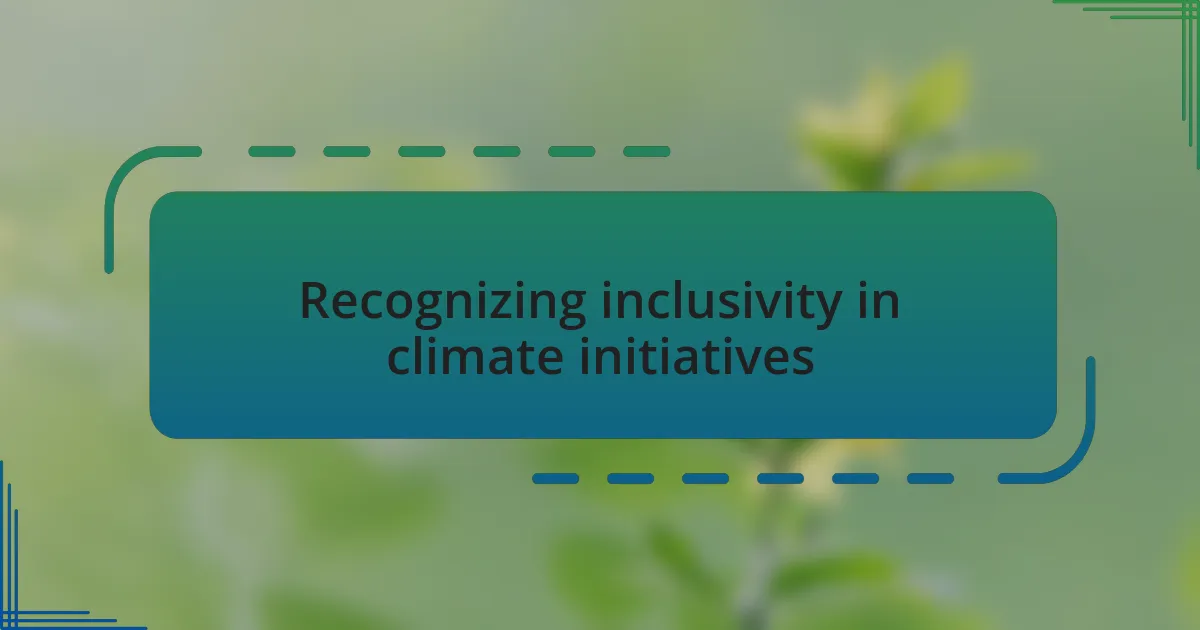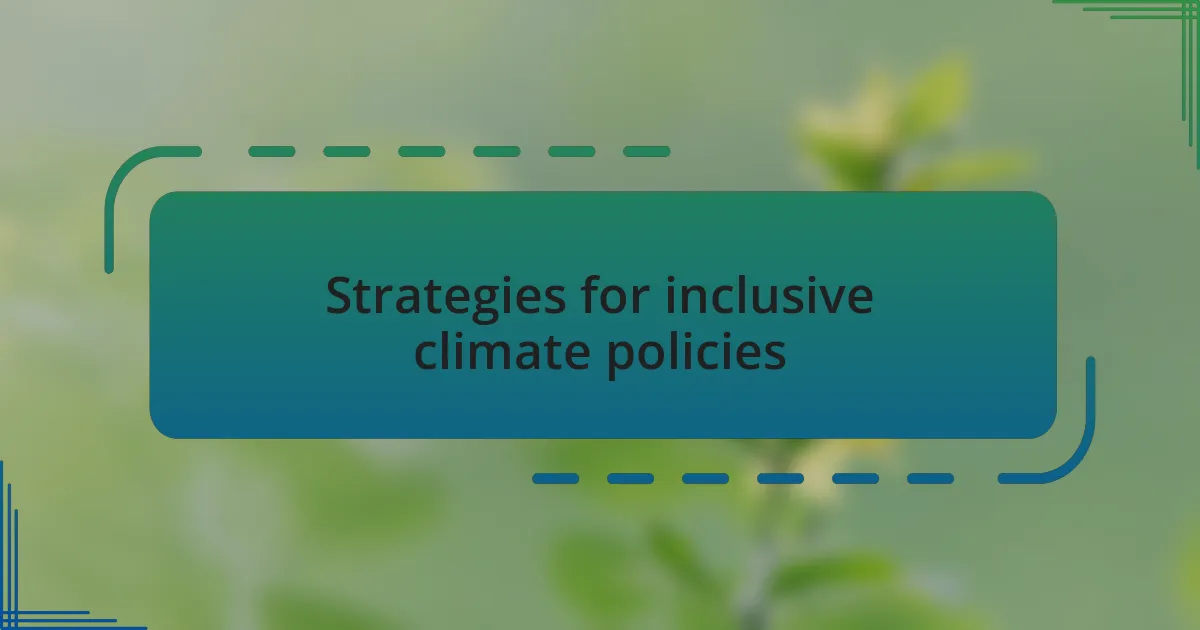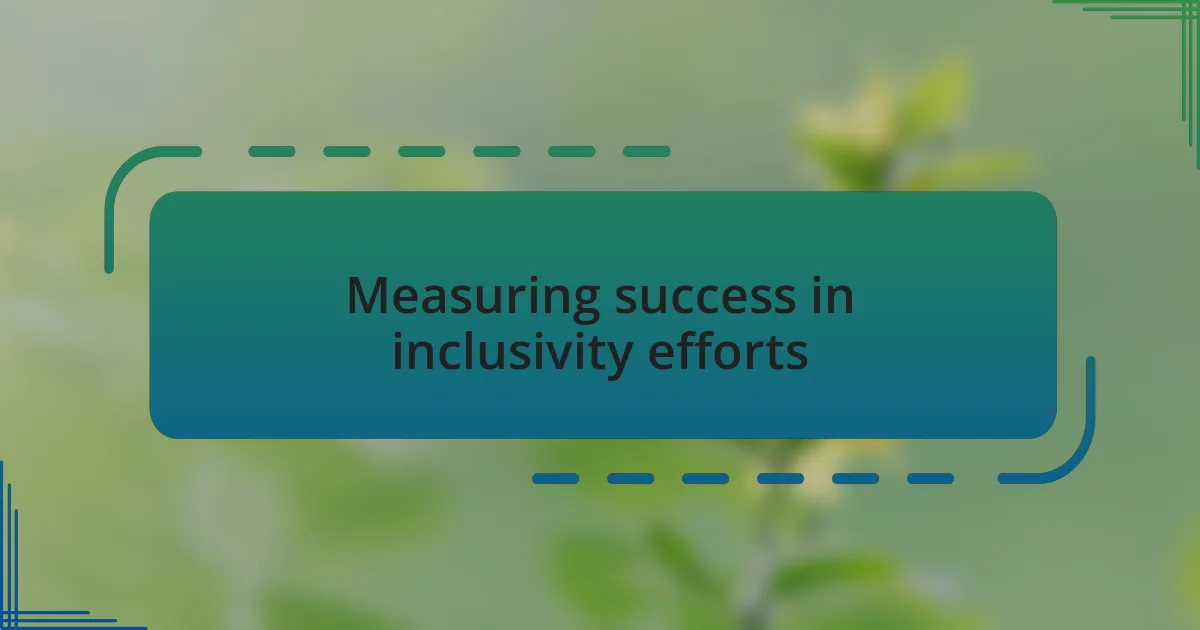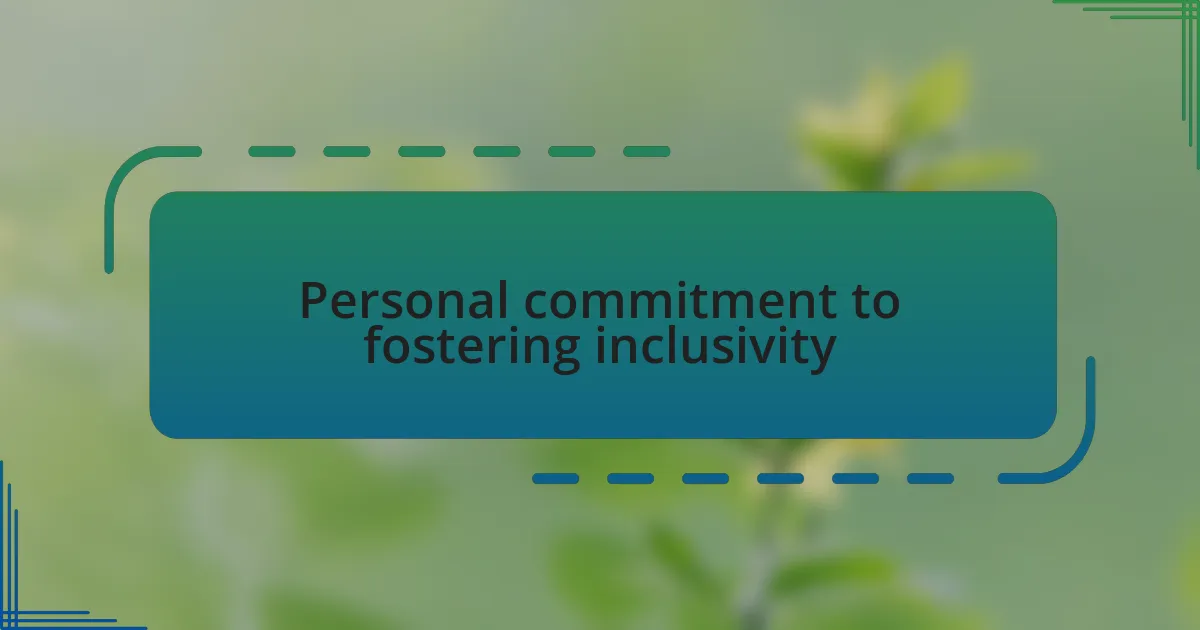Key takeaways:
- Climate action is essential for improving quality of life and creating a sustainable future for generations, emphasizing the importance of community efforts.
- Inclusivity in climate initiatives enriches discussions and leads to more effective solutions by ensuring diverse voices are represented.
- Building partnerships with grassroots organizations and marginalized communities enhances policy outcomes and empowers underrepresented groups.
- Measuring success in inclusivity efforts requires both qualitative feedback from communities and quantitative metrics to capture the full impact of initiatives.

Understanding climate action importance
Climate action is vital because it directly affects our quality of life and the world we leave for future generations. I vividly remember the first time I witnessed the devastating impact of pollution on a local river—it was both shocking and heartbreaking. This experience drove home the importance of taking steps now to protect our environment.
It’s easy to feel overwhelmed by the sheer scale of climate issues, but every small action counts. For example, when I joined a community clean-up project, I was struck by how many people came together, inspired by the shared goal of restoring our local park. This sense of community emphasized how interconnected we are; our collective efforts can lead to significant change.
Reflecting on the urgency of climate action, I often ask myself: What kind of planet are we leaving for our children? It’s a question that motivates me to advocate for sustainable practices and to engage others in meaningful dialogue. Understanding that our choices today shape the future can inspire us to act with passion and responsibility.

Recognizing inclusivity in climate initiatives
Recognizing inclusivity in climate initiatives is crucial for ensuring that the diverse voices of our global community are heard. I once participated in a town hall meeting focused on environmental policy, and it opened my eyes to the perspectives of marginalized groups who often bear the brunt of climate change impacts. Their stories highlighted the urgent need to include everyone in the conversation, reminding me that climate action isn’t just about the environment—it’s about people.
In my experience, effective climate initiatives actively seek input from underrepresented communities. For instance, when a local organization organized a workshop for residents from various backgrounds, we discovered innovative solutions that would have otherwise gone unnoticed. It was inspiring to see how including different viewpoints not only enriched the discussion but also led to more comprehensive and effective action plans.
Have you ever noticed how some initiatives tend to overlook certain groups? I’ve found that addressing this gap not only helps foster inclusivity but also strengthens our collective resolve to tackle climate challenges. By recognizing and embracing the diversity of our communities, we can unite in a shared mission—one that acknowledges that everyone has a stake in the fight against climate change.

Strategies for inclusive climate policies
To develop inclusive climate policies, it’s vital to engage directly with marginalized communities, ensuring their concerns shape decision-making processes. I vividly recall an initiative in my city where local leaders collaborated with Indigenous groups, leading to a policy that respected traditional knowledge while promoting environmental conservation. This experience reinforced my belief that inclusivity not only enriches policy outcomes but empowers the very people who are often left out of crucial conversations.
Building partnerships with grassroots organizations is another strategic approach I’ve witnessed make a significant difference. During a climate awareness campaign I was involved in, we worked closely with youth from diverse backgrounds. Their fresh perspectives ignited discussions that altered the direction of our strategy, illustrating how inclusive collaboration can lead to innovative and practical solutions that resonate with the community’s values.
It’s also essential to create spaces where voices can be shared openly without fear or hesitation. Once, I attended a forum designed to elevate the narratives of climate refugees. The stories shared that day left me moved and energized, showcasing the power of storytelling in shaping policies. How often do we invite these crucial voices into our planning sessions? By actively soliciting input from those most affected, we forge a path toward more equitable and effective climate action.

Building partnerships for inclusive solutions
Establishing strong partnerships is vital when it comes to tackling climate challenges inclusively. I recall a neighborhood project where we partnered with local farmers who faced daily climate threats. Their hands-on experience provided insights that experts often overlook, revealing practical solutions rooted in real-life impacts. Isn’t it fascinating how collaboration can bridge the gap between theory and practice?
Engaging with organizations that represent underrepresented voices is another step I’ve found incredibly impactful. Once, I joined forces with a non-profit focused on urban communities, where we facilitated workshops to gather input on climate initiatives. The ideas emerged from these sessions were powerful, often shedding light on issues I had never considered. I wonder how many other innovative solutions are waiting to be uncovered when we include those who live at the edge of policymaking?
I believe it’s critical to recognize that partnership isn’t just about sharing resources; it’s about sharing authority. During the development of a local sustainability plan, we made it a point to ensure that the community had equal say in the decisions. The excitement was palpable, and the final plan reflected a diverse range of voices and needs. How can we ensure that every stakeholder feels truly valued in these collaborations? It’s through consistent dialogue and shared leadership that we build trust and drive meaningful change.

Measuring success in inclusivity efforts
When it comes to measuring success in inclusivity efforts, I prioritize qualitative feedback from the communities involved. I once attended a focus group where participants shared how our initiatives affected their daily lives. Listening to their stories provided a depth of understanding that survey numbers simply can’t capture. It made me realize: how do we ensure that these voices continue to resonate in our evaluation processes?
Quantitative metrics also play a role, but I have discovered that they often miss the nuances of inclusion. For instance, tracking the diversity of participants in an initiative can show growth, yet it’s the emotional responses that tell the real story. I remember seeing a community member light up when her suggestion was implemented, highlighting the true impact of our efforts. Isn’t it critical that we not only look at the numbers but also the human experience behind them?
Additionally, setting specific, achievable goals can help in assessing progress. I once spearheaded an initiative aimed at increasing participation from marginalized groups by 30%. Regular check-ins allowed us to adjust our strategies on the fly based on participant feedback. This adaptive approach not only kept us aligned with our goals but fostered an environment of genuine inclusivity. How often do we really revisit our targets to keep the conversation alive and engage everyone involved?

Personal commitment to fostering inclusivity
My personal commitment to fostering inclusivity is rooted in genuine engagement with diverse communities. I vividly remember volunteering at a community garden where participants from various backgrounds collaborated to create something meaningful together. It was enlightening to see how the shared experience of cultivating plants forged connections and encouraged dialogue. Isn’t it fascinating how a simple activity can break down barriers?
To me, inclusivity isn’t just a checkbox; it’s about creating a culture where everyone feels they belong. I once facilitated a workshop where participants shared their unique perspectives on climate action. The vulnerability and openness in that room were profound, reminding me that real inclusivity means not only inviting voices but also amplifying them. How often do we reflect on the stories we hear and the lives we affect as a result?
Embracing a mindset of continuous learning is essential for fostering true inclusivity. After organizing a fundraising event, I solicited feedback from attendees about their experiences. Some shared feelings of exclusion, and I realized I had overlooked certain accessibility needs. That moment was humbling; it taught me that progress requires humility and a willingness to adapt. Every interaction is an opportunity for growth, isn’t it?